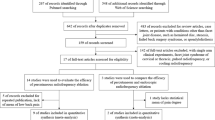Abstract
Facet joint pain is an important aspect of degenerative lumbar spine disease, and radiofrequency medial branch neurotomy remains an established therapy, while cryodenervation has still been poorly examined. This study was undertaken to examine the effects of medial branch cryodenervation in the treatment of lumbar facet joint pain. This was a prospective clinical case series. Patient selection was based on the history, physical examination and positive medial branch blocks. Percutaneous medial branch cryodenervation was performed using a Lloyd Neurostat 2000. Target parameters were low back pain (VAS), limitation of activity (McNab) and overall satisfaction. Fifty patients were recruited, and 46 completed the study. The follow-up time was 1 year. At 6 weeks, 33 patients (72%) were pain free or had major improvement of low back pain; 13 (28%) had no or little improvement. Including failures, mean low back pain decreased significantly from 7.7 preoperatively to 3.2 at 6 weeks, 3.3 at 3 months, 3.0 at 6 months and 4.2 at 12 months (P<0.0001). Limitation of the activities of daily living improved parallel to reduced pain. Our results suggest that medial branch cryodenervation is a safe and effective treatment for lumbar facet joint pain.
Résumé
But de l’étude : les douleurs facétaires articulaires sont un élément important de la pathologie dégénérative de la colonne lombaire et la neurotomie par radio fréquence de la branche médiale est un traitement classique, alors que les résultats de la cryodénervation ne sont pas considérés comme évidents. Cette étude a pour but d’examiner les effets de la cryodénervation des rameaux médians dans le traitement des douleurs facétaires. L’étude a été menée de façon prospective. Les patients ont été sélectionnés selon leur histoire, l’examen physique et la positivité de la réalisation d’une infiltration des rameaux médians. La cryodénervation par voie percutanée a été réalisée par un appareil Lyod Neurostat 2000. Les paramètres étudiés ont été les lombalgies (VAS), la limitation d’activité (McNab) et la satisfaction. Cinquante patients ont été recrutés pour ce traitement, 46 sujets ont été spécialement étudiés et suivis pendant au moins un an. Résultats : à 6 semaines, 33 patients (72%) ne présentent aucune douleur et ont une grande amélioration de leur lombalgie, 13 (28%) n’ont pas ou simplement ont une petite amélioration. Malgré les échecs, les douleurs lombaires diminuent de façon significative avec une échelle de 7.7 préopératoire à 3.2 à 6 semaines, de 3.3 à 3 mois, de 3.0 à 6 mois et 4.2 à 12 mois (P<0.0001). En conclusion, nous pouvons affirmer, aux vues de nos résultats que la cryodénervation des rameaux médians est un procédé donnant de bons résultats réguliers dans le traitement des syndromes facétaires douloureux.




Similar content being viewed by others
References
Bärlocher CB, Krauss JK, Seiler RW (2003) Kryorhizotomy: an alternative technique for lumbar medial branch rhizotomy in lumbar facet syndrome. J Neurosurg 98:14–20
Bogduk N, Long DM (1979) The anatomy of the so-called “articular nerves” and their relationship to facet denervation in the treatment of low-back pain. J Neurosurg 51:172–177
Bogduk N, Long DM (1980) Percutaneous lumbar medial branch neurotomy: a modification of facet denervation. Spine 5:193–200
Bogduk N, Colman RR, Winer CE (1977) An anatomical assessment of the “ercutaneous rhizolysi” procedure. Med J Aust 1:397–399
Dreyfuss P, Schwarzer AC, Lau P et al (1997) Specificity of lumbar medial branch and L5 dorsal ramus blocks. A computed tomography study. Spine 22:895–902
Dreyfuss P, Halbrook B, Pauza K et al (2000) Efficacy and validity of radiofrequency neurotomy for chronic lumbar zygapophysial joint pain. Spine 25:1270–1277
Dreyfuss PH, Dreyer SJ, Herring SA (1995) Lumbar zygapophysial (facet) joint injections. Spine 20:2040–2047
Fukui S, Ohseto K, Shiotani M et al (1997) Distribution of referred pain from the lumbar zygapophyseal joints and dorsal rami. Clin J Pain 13:303–307
Ghormley RK (1933) Low back pain with special reference to the articular facets with presentation of an operative procedure. JAMA C1:1773
Hildebrandt J (2001) [Relevance of nerve blocks in treating and diagnosing low back pain-is the quality decisive?]. Schmerz 15:474–483
Kaplan M, Dreyfuss P, Halbrook B et al (1998) The ability of lumbar medial branch blocks to anesthetize the zygapophysial joint. A physiologic challenge. Spine 23:1847–1852
Lau P, Mercer S, Govind J et al (2004) The surgical anatomy of lumbar medial branch neurotomy (facet denervation). Pain Med 5:289–298
Manchikanti L (1999) Facet joint pain and the role of neural blockade in its management. Curr Rev Pain 3:348–358
Mattmüller R (2002) Radiofrequenzläsion und Kryoläsion. In: Hankemeier U, Hildebrandt J (eds) Neurodestruktive Verfahren in der Schmerztherapie, 2nd edn. Springer, Berlin Heidelberg New York, pp 19–32
Saal JS (2002) General principles of diagnostic testing as related to painful lumbar spine disorders: a critical appraisal of current diagnostic techniques. Spine 27:2538–2545; discussion 2546
Schuster GD (1982) The use of cryoanalgesia in the painful facet syndrome. J Neurol Orthop Surg 3:271–274
Shealy CN (1975) Percutaneous radiofrequency denervation of spinal facets. Treatment for chronic back pain and sciatica. J Neurosurg 43:448–451
Taguchi T (2005) [The indication and clinical value of neural blocks for low back pain]. Clin Calcium 15:17–22
van Kleef M, Barendse GA, Kessels A et al (1999) Randomized trial of radiofrequency lumbar facet denervation for chronic low back pain. Spine 24:1937–1942
Author information
Authors and Affiliations
Corresponding author
Rights and permissions
About this article
Cite this article
Birkenmaier, C., Veihelmann, A., Trouillier, H. et al. Percutaneous cryodenervation of lumbar facet joints: a prospective clinical trial. International Orthopaedics (SICO 31, 525–530 (2007). https://doi.org/10.1007/s00264-006-0208-6
Received:
Accepted:
Published:
Issue Date:
DOI: https://doi.org/10.1007/s00264-006-0208-6




